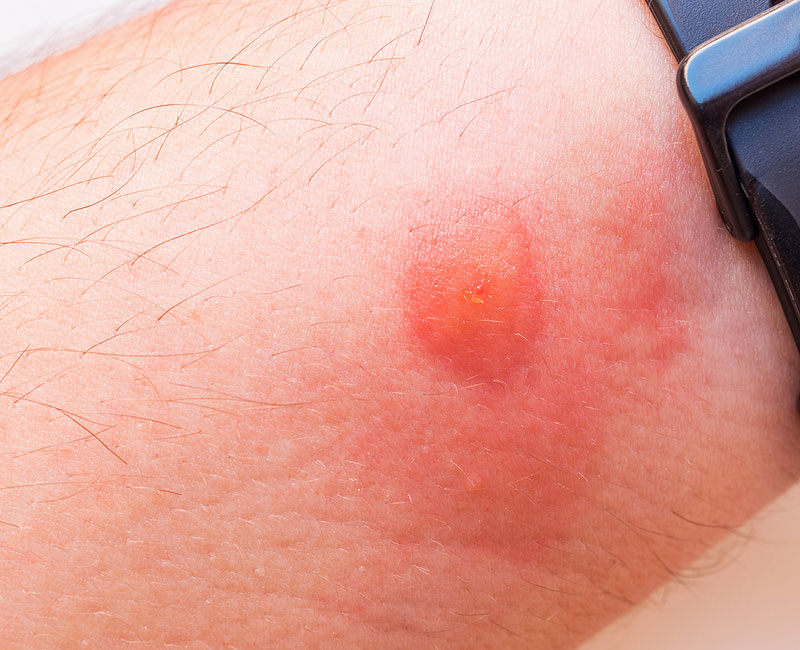Horsefly bites cause raised, discolored bumps on your skin. They’re painful but usually harmless. At-home care can help with symptoms. In rare cases, you may develop an allergic reaction, infection or a bacterial infection called tularemia. These require medical treatment.
Advertisement
Cleveland Clinic is a non-profit academic medical center. Advertising on our site helps support our mission. We do not endorse non-Cleveland Clinic products or services. Policy

A horsefly (Tabanus spp.) is a large fly that commonly lives near bodies of water and where it can easily access mammals. It gets its name because it’s a frequent pest of horses and other mammals (including humans).
Advertisement
Cleveland Clinic is a non-profit academic medical center. Advertising on our site helps support our mission. We do not endorse non-Cleveland Clinic products or services. Policy
Female horseflies bite to feed on blood. They have well-developed mouthparts for tearing skin and a sponge-like tongue that soaks up blood. This is different from mosquitos, for example, which pierce your skin and then suck blood. This also explains why you can typically feel a horsefly bite as it’s happening but not a mosquito bite.
Horsefly bites are painful, but they’re usually not harmful to humans. But it’s possible to have an allergic reaction to a bite or develop an infection from it. In very rare cases, a horsefly can pass on a bacterial infection called tularemia through a bite.
A horsefly bite typically looks like a raised bump of red or discolored skin. You’ll likely only have one or a couple of bites. These bites are painful, so you’ll likely swat the horsefly away before it can bite again.
Horseflies have a gray or blackish body and are 10 to 30 millimeters long. They also have large eyes and stout bodies. There are over 160 species of horseflies.
Adult horseflies are fast fliers that most often attack moving, dark objects because they see these as food sources. They exist in most areas of the world except for some islands and the polar regions.
Female horseflies are relentless in their search for blood, so horsefly bites can be quite common if they live near you. If you live on or near a farm with livestock, you’ve probably encountered many horsefly bites. However, horseflies are more likely to bite cows and horses than humans.
Advertisement
Horseflies are most active in warm and wet weather.
The first sign of a horsefly bite is pain. You may see a horsefly on you as you feel the pain from the bite. After the bite, you’ll likely have a raised, red or discolored area of skin that may be sensitive to touch. You may also notice a little bit of blood.
In most cases, horsefly bites heal and go away within a matter of days.
It’s rare to have complications related to a horsefly bite, but they can include:
In extreme cases, bites can cause an allergic reaction. Horseflies release a protein when they bite you that slows blood clotting. Some people may develop an allergic reaction to this protein.
Symptoms of an allergic reaction from a horsefly bite include:
Minor allergic reactions typically go away on their own with time. If these symptoms continue to get worse, talk to your healthcare provider.
Signs of a severe allergic reaction (anaphylaxis) include:
Anaphylaxis is life-threatening. Call 911 (or your local emergency service number) or go to the nearest hospital if you have symptoms of anaphylaxis.
It’s possible to develop an infection after a horsefly bite. This is more likely to happen if you scratch at the bite and don’t keep it clean. Symptoms of a skin infection (cellulitis) include:
You should see a healthcare provider if you have signs of an infection. Infections need treatment with antibiotics.
In rare cases, horseflies can transmit (pass on) a bacterial infection called tularemia through bites. This mainly affects wild rodents, but ticks, biting flies and mosquitoes can pass it on to humans.
Symptoms of tularemia develop three to five days after exposure. They typically come on quickly after that time span and can include:
Advertisement
See a healthcare provider if you have these symptoms.
Female horseflies need blood to stimulate egg production for reproduction. They can be relentless and aggressive as they look for mammals (like horses, cows and humans) to bite.
Male horseflies don’t produce eggs, so they don’t need blood. They mainly feed on pollen and plant nectars.
If you get a horsefly bite, wash the area with soap and water to help lower the chance of infection.
Most bites get better in a few days. But there are some things you can do at home to ease your symptoms, including:
Try to avoid picking at or scratching the bite area.
Some steps you can take to help prevent horsefly bites include:
Advertisement
If you notice increasing numbers of horseflies in your area, consider talking to a pest control specialist.
If you develop signs of an allergic reaction, infection or tularemia after a horsefly bite, see your healthcare provider.
Horsefly bites are a painful, pesky reality for many people who live in areas with warm and wet weather. In most cases, horsefly bites are ultimately harmless. But, like all insect bites and stings, you should keep the area clean and avoid scratching it to prevent infection. Contact your healthcare provider if your symptoms last longer than a few days or if you develop an allergic reaction.
Advertisement
Cleveland Clinic’s primary care providers offer lifelong medical care. From sinus infections and high blood pressure to preventive screening, we’re here for you.

Last reviewed on 02/12/2024.
Learn more about the Health Library and our editorial process.